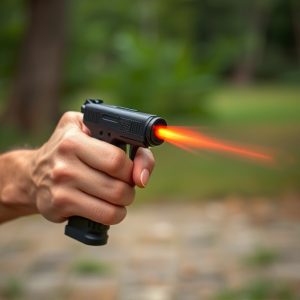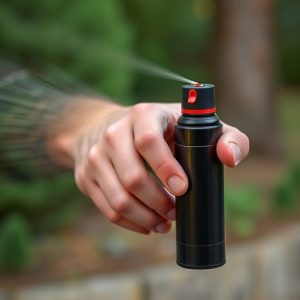Pepper Spray Training 101: Equipment, Safety, & Legal Guidelines
Pepper spray training for beginners is crucial for law enforcement, focusing on correct usage techni…….
Pepper spray training for beginners is crucial for law enforcement, focusing on correct usage techniques, decontamination, and awareness of health risks. Choosing user-friendly, reliable equipment with safety guidelines ensures accurate deployment and minimizes risks. Comprehensive training goes beyond application, covering use cases, risk assessment, de-escalation strategies, legal implications, and documentation requirements to balance public safety and justice while navigating evolving legal standards.
“Unleashing the power to control: A Comprehensive Guide to Law Enforcement Pepper Spray Equipment. From understanding the benefits and safety precautions of pepper spray to choosing the right equipment, this article is your ultimate resource. We explore effective deployment techniques through in-depth training methods, best practices, and legal considerations. Aimed at beginners, it offers a detailed look at responsible use protocols, ensuring law enforcement officers are prepared and equipped for real-world scenarios. Discover the essential Pepper Spray Training for Beginners.”
- Understanding Pepper Spray: Benefits and Safety Precautions
- Choosing the Right Equipment for Effective Deployment
- Comprehensive Training: Techniques and Best Practices
- Legal Considerations and Responsible Use Protocols
Understanding Pepper Spray: Benefits and Safety Precautions
Pepper spray is a non-lethal chemical agent that has become an integral part of law enforcement equipment globally. Its primary purpose is to temporarily incapacitate an individual, providing officers with crucial time to control and subdue suspects safely. The active ingredient in pepper spray is capsaicin, which is derived from chili peppers. When deployed, it irritates the eyes, nose, throat, and skin, leading to temporary blindness, coughing, and difficulty breathing. This effect lasts for a few minutes, allowing individuals to recover without long-term harm.
While pepper spray offers significant advantages in law enforcement situations, proper training and safety precautions are essential. Pepper spray training for beginners should cover the correct usage techniques, including aiming, spraying distance, and the recognition of different types of pepper spray. Officers must also be educated about decontamination procedures to ensure their safety and that of the individuals affected. Understanding the potential risks and side effects is vital, especially when encountering individuals with specific health conditions or sensitive skin.
Choosing the Right Equipment for Effective Deployment
Choosing the right pepper spray equipment is paramount for law enforcement agencies aiming to equip their officers effectively. It involves considering factors like the specific needs of various tactical scenarios, officer fitness and comfort, as well as compliance with local regulations.
For beginners in pepper spray training, it’s crucial to start with products that are user-friendly, reliable, and backed by comprehensive safety guidelines. Quality equipment ensures accurate deployment, minimizing risk to both officers and civilians. Advanced features like adjustable nozzle settings, ergonomic designs, and quick-release holsters can significantly enhance operational efficiency during high-stress situations.
Comprehensive Training: Techniques and Best Practices
Comprehensive Pepper Spray Training for Beginners is an essential component in preparing law enforcement officers for real-world scenarios. This training goes beyond simple application techniques, delving into effective use cases, risk assessment, and de-escalation strategies. By mastering these skills, officers can ensure the safe and responsible deployment of pepper spray during encounters with suspects.
The best practices emphasize the importance of proper technique, including accurate targeting and understanding the spray’s range and duration. Training also educates beginners on the legal implications and documentation requirements following the use of pepper spray, ensuring a balanced approach to maintaining public safety and upholding justice.
Legal Considerations and Responsible Use Protocols
In the context of law enforcement, pepper spray equipment is a powerful tool that requires careful consideration and responsible use protocols. Legal considerations surrounding its employment are vast and complex, with regulations varying by jurisdiction. Officers must be well-versed in their region’s specific laws governing the use of force, including when and how pepper spray can be deployed legally. Misuse or excessive application of pepper spray can lead to severe legal repercussions for officers, making comprehensive training an indispensable foundation.
For beginners in Pepper Spray Training, understanding the ethical and legal boundaries is paramount. This includes recognizing situations where pepper spray is a proportionate response, ensuring proper documentation after its use, and mitigating potential civil liberties concerns. Regular refresher courses and continuous professional development are crucial to stay updated with evolving legal standards and maintain responsible practices when utilizing this equipment in high-pressure law enforcement scenarios.
Pepper spray equipment is a valuable tool in law enforcement, offering a non-lethal means of self-defense and crowd control. However, its effective use requires proper training and adherence to safety protocols. For those new to pepper spray, understanding the benefits and learning best practices through comprehensive training, like Pepper Spray Training for Beginners, is essential. Legal considerations must also be navigated to ensure responsible use, making informed equipment choices and ongoing education key components of modern law enforcement strategies.


